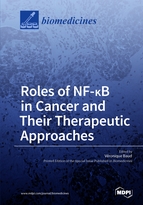Roles of NF-κB in Cancer and Their Therapeutic Approaches
A special issue of Biomedicines (ISSN 2227-9059). This special issue belongs to the section "Molecular and Translational Medicine".
Deadline for manuscript submissions: closed (1 March 2018) | Viewed by 137959
Special Issue Editor
2. Faculté de Pharmacie, 4 Avenue de l'Observatoire, 75006 Paris, France
Interests: interface between signal transduction and cancer with a focus on the alternative NF-kappaB signaling pathway, how it is regulated, and its contributions towards tumor development and resistance to conventional cancer therapies
Special Issues, Collections and Topics in MDPI journals
Special Issue Information
Dear Colleagues,
Although mortality rates have declined in recent years, the majority of cancers are still difficult to treat and the medical need for better cancer treatment is evident. The current anticancer armamentarium includes many active agents that are applied across tumor types. However, most of these broadly-active anticancer drugs have a small therapeutic index and barely discriminate between malignant and normal cells. In recent years the focus has shifted to the development of rationally designed, molecularly-targeted therapy for the treatment of a specific cancer, therefore offering the promise of greater specificity coupled with reduced systemic toxicity. NF-κB transcription factor family as emerged as such a promising target for cancer therapy. This Special Issue will explore the routes from NF-κB basic research, cancer research and oncogenomics into the development of NF-κB-based cancer therapeutics and biomarkers.
We invite research and review papers in any area of the NF-κB field that are related, but not limited to, fundamental understanding of NF-κB signaling pathways, gene expression profiling, epigenetic regulation, diagnostic, prognostic and pharmacogenomic biomarkers, molecular targets driving the progression of human cancers, cancer drug development on these targets, clinical trial with new agents, and validation in animal models.
We hope that this Special Issue reflects the exciting era that we are living in with respect to the field of NF-κB and its applications in cancer research.
Dr. Véronique Baud
Guest Editor
Manuscript Submission Information
Manuscripts should be submitted online at www.mdpi.com by registering and logging in to this website. Once you are registered, click here to go to the submission form. Manuscripts can be submitted until the deadline. All submissions that pass pre-check are peer-reviewed. Accepted papers will be published continuously in the journal (as soon as accepted) and will be listed together on the special issue website. Research articles, review articles as well as short communications are invited. For planned papers, a title and short abstract (about 100 words) can be sent to the Editorial Office for announcement on this website.
Submitted manuscripts should not have been published previously, nor be under consideration for publication elsewhere (except conference proceedings papers). All manuscripts are thoroughly refereed through a single-blind peer-review process. A guide for authors and other relevant information for submission of manuscripts is available on the Instructions for Authors page. Biomedicines is an international peer-reviewed open access monthly journal published by MDPI.
Please visit the Instructions for Authors page before submitting a manuscript. The Article Processing Charge (APC) for publication in this open access journal is 2600 CHF (Swiss Francs). Submitted papers should be well formatted and use good English. Authors may use MDPI's English editing service prior to publication or during author revisions.
Keywords
- NF-κB subunits
- NF-κB signaling pathways
- NF-κB related to:
- solid tumors
- hematological malignancies
- oncogenomics
- epigenetics
- gene expression profiling
- biomarkers
- miRNA
- ubiquitin-proteasome pathway
- molecular targets
- cancer targeted diagnosis
- cancer targeted therapeutics
- mechanism-based drug development
- clinical trials
- animal models







